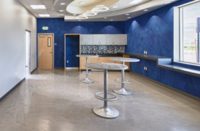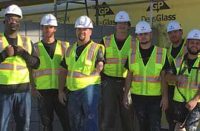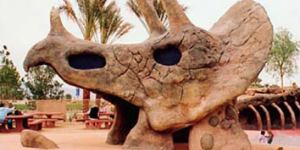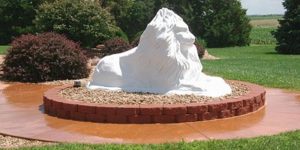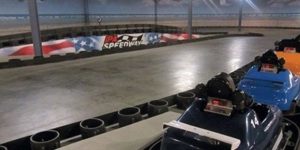 On the Nevada side of Lake Tahoe, there’s a sprawling residence on the lakeshore that has something its neighbors don’t have — a 24-foot tall mountain gushing numerous waterfalls, pools, and a meandering stream winding through the grounds. On the side of the mountain you can see an old, abandoned mineshaft with a rusted railcar on the siding. Live trees and shrubs, plants and flowers of all kinds merge this environment into the landscape. Birds fly from tree branch to streamside as water gently splashes over rocks. It certainly looks and sounds real, but it’s not.
On the Nevada side of Lake Tahoe, there’s a sprawling residence on the lakeshore that has something its neighbors don’t have — a 24-foot tall mountain gushing numerous waterfalls, pools, and a meandering stream winding through the grounds. On the side of the mountain you can see an old, abandoned mineshaft with a rusted railcar on the siding. Live trees and shrubs, plants and flowers of all kinds merge this environment into the landscape. Birds fly from tree branch to streamside as water gently splashes over rocks. It certainly looks and sounds real, but it’s not.
Under the mountain — accessible via the mineshaft door — are the electronic controls that run this elaborate water feature, which spans several acres. Water flow and water purification are all handled automatically. At the push of a button, controls for colored lights and fog machines can turn this naturalistic haven into a mesmerizing drama for the senses.
But building mountains for homeowners is only a fraction of what David Long and his team at Lakeland Company Inc. have accomplished. You’ll find Lakeland Co.’s creations across the country at upscale residences, casinos, zoos and museums, theme parks, restaurants, corporate offices, and even a hospital and airport. As word spreads, so does the reach of this Rathdrum, Idaho-based firm.
Long saw his own "signs" for the future
David Long, president of Lakeland Co., grew up working in his father’s sign business — creating, constructing and installing signs and three-dimensional displays. By the time he was 18 years old, he was a journeyman signwriter.
"We were involved with large-scale signage and displays, entailing several different construction and concrete methods," he says. "Being surrounded by multiple journeymen in this environment enabled me to learn more of the design and application methods which I rely upon today." But at the time, he wasn’t ready to follow in his father’s footsteps.
 Fifteen years after his father closed the business, Long took his family to northern Idaho, where he and his wife started Lakeland Sign & Display Co. in the spring of 1991. "Our first project was estimated at $152," he says, "and we grew from there due to the fact that we maintained the attitude that anything could be created provided you apply the right materials and application."
Fifteen years after his father closed the business, Long took his family to northern Idaho, where he and his wife started Lakeland Sign & Display Co. in the spring of 1991. "Our first project was estimated at $152," he says, "and we grew from there due to the fact that we maintained the attitude that anything could be created provided you apply the right materials and application."
Today, Lakeland Co. designs, manufactures and installs themed elements, artificial rock and water features, museum dioramas, simulated environments, Glass Fiber Reinforced Concrete panel systems, monument signage and architectural applications. Long is quick to acknowledge the contributions of others to his success.
"The team environment has allowed us to apply the strengths of each individual in different areas of required design, manufacturing, mobilization, shipping and construction application in order to create the highest quality of finish product possible," he says.
Get things right from the start
Long reports that the bulk of Lakeland’s business comes either from word-of-mouth or the company’s Web site.
Typically, 10 to 20 staff people work on any given project, plus Lakeland frequently outsources work to the local labor pool.
 Often there’s customer education involved, as many people don’t realize how very labor-intensive the work is, Long observes. "Time is spent educating a lot of our customers who are not familiar with the costs associated in producing these types of elements. We have learned through replication and tracking what our costs are and what our minimum profit requirements are to stay in business."
Often there’s customer education involved, as many people don’t realize how very labor-intensive the work is, Long observes. "Time is spent educating a lot of our customers who are not familiar with the costs associated in producing these types of elements. We have learned through replication and tracking what our costs are and what our minimum profit requirements are to stay in business."
Project costs vary based on the location of the project. Not only are local material prices factored in, but also travel, accommodations, shipping, transportation, staff per diem, and more. Thanks to the assistance of a management advisory team, Lakeland has incorporated all these variables into its estimating process.
 Ensuring that the customer understands what the final product is going to be also aids the process. "We combine the ability to hand draw and use computer programs as another tool to enhance project designs with faster service to our clients. We also provide scale models of larger projects to help our customers envision the final exhibit, while giving us an element to do better product estimates from."
Ensuring that the customer understands what the final product is going to be also aids the process. "We combine the ability to hand draw and use computer programs as another tool to enhance project designs with faster service to our clients. We also provide scale models of larger projects to help our customers envision the final exhibit, while giving us an element to do better product estimates from."
Lakeland uses a variety of materials
Many of Lakeland’s artificial environments rely on Glass Fiber Reinforced Concrete, which Long says he uses for its durability and highly detailed replication abilities. “We have developed our molding capabilities to mold and recreate just about anything imaginable,” he says.
 Lakeland’s GFRC mix is an alkali-resistant matrix of portland cement, graded silica sands and alkali-resistant chopped glass fiber. The material, which contains 4 percent to 5 percent glass content, is applied in a spray-up method, using concentric guns, and compacted in quarter-inch layers. The panels produce strength of approximately 6,000 pounds per square inch at 3…4" of thickness and can be left hollow or filled with concrete grout for structural applications. They can also be filled with two-part foam to discard hollow sound where weight is a concern.
Lakeland’s GFRC mix is an alkali-resistant matrix of portland cement, graded silica sands and alkali-resistant chopped glass fiber. The material, which contains 4 percent to 5 percent glass content, is applied in a spray-up method, using concentric guns, and compacted in quarter-inch layers. The panels produce strength of approximately 6,000 pounds per square inch at 3…4" of thickness and can be left hollow or filled with concrete grout for structural applications. They can also be filled with two-part foam to discard hollow sound where weight is a concern.
“Most projects we grout fill to further the quality of the application.” Long says. “We have not had any structural problems with panel or boulders in freeze-thaw conditions as the result of quality control during manufacturing.”
While 60 percent to 80 percent of a Lakeland project may utilize GFRC, you’ll also see positive carved concrete, textured concrete overlays and real rock. To simulate eroded shorelines and cut banks, shotcrete is used. “Very seldom do we do all artificial,” says Long. “That’s primarily in indoor environments. In exterior applications we strive to use real rock in and around the artificial.”
 Coloring methods vary with each project
Coloring methods vary with each project
Long says his company typically doesn’t color dust their molds, because you’ll have grout seams anyway. His preference is toapply a base coat in a random color application after the panels are grouted together.
“Our base coats consist of a very fine concrete color coat mixed with acrylic admixture to promote excellent adhesive capabilities. The bulk of the color base coat is applied with a very fine concrete color coating so as not to lose the detail of the panel textures.” Acid stains may be used in different combinations to create various effects.  Painting techniques, such as creating washed areas with water-based acrylics, are used as accents — for example, to replicate oxide or soil residues. Especially with large outdoor projects, the company will often work with local landscapers to color-match local stone.
Painting techniques, such as creating washed areas with water-based acrylics, are used as accents — for example, to replicate oxide or soil residues. Especially with large outdoor projects, the company will often work with local landscapers to color-match local stone.
Long has also used these and other color and texture methods to re-create antiquities or period pieces.
Maintenance of artificial environments is minimal, Long says. The greatest challenge is ultraviolet light damage, but it helps to apply a penetrating sealer after the coloring is complete.
“We have found that our coloring process will hold its color about 3-to-5 years…. We have had customers refresh the coloring on their project at that time and others who leave it due to the fact that they like the way it has weathered and find it looks more natural.”
Challenges create opportunity
“Each project in itself is challenging from the standpoint of striving to constantly better the finish look and application methods,” reflects Long. Replicating trees and architectural antiquities takes a special touch. One project included creating a trail of fire through a waterfall.
 Of course, some projects are much more challenging than others. Take the Lake Tahoe project for example. The decision to incorporate the mechanical room into a “mountain” forced them to keep ahead of the tight construction schedule by re-engineering, designing on site, changing rock work and the pump/control systems simultaneously without stopping construction, Long recalls.
Of course, some projects are much more challenging than others. Take the Lake Tahoe project for example. The decision to incorporate the mechanical room into a “mountain” forced them to keep ahead of the tight construction schedule by re-engineering, designing on site, changing rock work and the pump/control systems simultaneously without stopping construction, Long recalls.
A project in Cripple Creek, Colo., presented an interesting altitude-related challenge. “The lack of air was obvious during the project, and we were forced to sit down and catch our breath multiple times throughout each day.”
Then there was a project for the U.S. Bureau of Mines to replicate a mine shaft interior for its training facilities. The job site was two stories underground. Lakeland had to crane concrete panels down through a vertical shaft, cart them to their location, and then lift and bolt them to the ceiling, which was constructed of 25,000-psi concrete 2 feet thick, with pipe sleeves through to the surface. “We had to run all thread through those sleeves to secure the panel placements, and that enabled us to recreate the plate bolting that occurs to anchor loose rock in real mineshafts,” Long says. “We also paneled the walls and created what appeared to be natural seepage and water emitting from rock crevasses into mineshaft drain trenches.”
 Long’s advice for others interested in this area of the industry? “Be patient. Be willing to go into the unknown areas of the normal construction trades, as this is a combination of art and heavy construction methods. Gain as much knowledge as possible and be willing to spend a lot of time and money on research and development.”
Long’s advice for others interested in this area of the industry? “Be patient. Be willing to go into the unknown areas of the normal construction trades, as this is a combination of art and heavy construction methods. Gain as much knowledge as possible and be willing to spend a lot of time and money on research and development.”
Other recommendations cover good business practices. “Be prepared to be accountable and make right any failures of product or application methods in order to keep your client, projects and reputation intact. Sometimes, no matter what you do, you will not make some clients happy. Therefore, do the best you can prior to contracting — survey them like they will do with your company to see if you foresee any possible difficulties during and after construction or payment for construction.”
When your project takes you to a new location, treat local suppliers the way you want to be treated, Long says. “If we come into an area, we need to leave a positive reflection when we leave. We may return some day.”
 “Challenging and rewarding,” that’s how Long describes his involvement in the industry thus far. Stimulating and encouraging might also apply. “The more projects you have completed the more you want,” he says, “as the elements associated with each project allow us to rise to the next level of imagination.”
“Challenging and rewarding,” that’s how Long describes his involvement in the industry thus far. Stimulating and encouraging might also apply. “The more projects you have completed the more you want,” he says, “as the elements associated with each project allow us to rise to the next level of imagination.”
